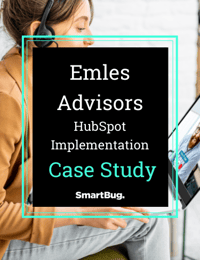
How to Use Buyer Personas in the Financial Services Industry
June 14, 2019
From personal banking to loans and mortgages to financial advising and other financial offerings, the financial services industry serves a variety of customers. Whether you work for a bank, credit union, credit card company, insurance company, or another kind of financial institution, understanding who your ideal customers are and where you can reach them is an important part of your marketing strategy.
Ryan Malone, CEO of SmartBug Media™, explains a buyer persona as “a profile that describes your ideal customer.” Understanding your buyer personas is a critical first step in any financial services marketing campaign.
Developing Buyer Personas
When you define a buyer persona, you identify the ideal customers for your financial services company and what makes them want to work with you.
You can’t define buyer personas by making an educated guess or assumptions; you need to have real conversations with real customers. By understanding common characteristics of your ideal customers—such as demographics, business roles, goals, and pain points—you can determine what led them to invest in your services and what you need to do to attract other leads like them.
Do you have loyal customers that would be willing to chat about their experiences?
Talk to customers that use a variety of your financial services. For instance, if you’re a credit union, you might talk to a few customers who use business bank accounts, a few who have a mortgage loan, and a few who applied for a credit card.
By having a conversation about who they are, what they are hoping to achieve, and what prompted them to choose your institution over another, you can tailor content to their specific needs.

Let’s create a sample buyer persona for that credit union. We’ll call her Mortgage Mary.
Mortgage Mary
- Location: Midwest
- Age: 28
- Gender: Female
- Education: Bachelor of Arts
- Hobbies: Traveling to visit friends and family, exercising, reading
- Job Title: Sales Consultant
- Income: $65,000
- Relationship Status: In a committed relationship, no kids
- Goals: Purchase her first home by 30, continue making payments toward student loans, travel to two new places each year
- Challenges: Limited disposable income due to student loans
Summary: Mary is a 28-year-old female who lives in the Midwest and works at a medium-sized company as a sales consultant. Although she brings in a decent salary, Mary’s monthly bills and student loan payments leave her with little disposable income. Mary loves to travel, but feels guilty spending money on travel when she is saving for her first home. Mary’s goal is to buy her first home before age 30, and she has started the research process. She is in a committed relationship, but will be purchasing her first home on her own. When seeking information, Mary talks to friends and searches the internet. As a first-time homebuyer, she is looking into different types of loans to see which might be the best option.
Using Your Buyer Personas for Your Financial Services Marketing
Once you’ve gotten to know your personas, the next step is using them to inform your marketing efforts. For each persona you develop, you should also research their Buyer’s Journey.
Let’s talk through the Buyer’s Journey. HubSpot defines the Buyer’s Journey as “the process buyers go through to become aware of, consider and evaluate, and decide to purchase a new product or service.” The three stages include awareness, consideration, and decision.
In the awareness stage, the buyer becomes aware of a problem they need to fix. The consideration stage involves the buyer defining the problem and researching options that may be able to fix it. In the decision stage, the buyer chooses the option that will best solve their problem.
Let’s walk Mortgage Mary through the Buyer’s Journey.
Mary’s awareness stage stems from her goal to purchase a house by age 30. In this stage, Mary might ask friends about their experiences purchasing homes. She will likely read blog posts and other articles about first-time home buying.
To reach Mary, your financial institution may consider publishing a series of blog articles on everything mortgage-related: understanding your finances, getting pre-approved, loan options, finding a realtor, attending open houses, and more. There are a plethora of topics that will help educate Mary as a first-time homebuyer. To educate alongside a blog, you might build an infographic to paint a visual picture of the home-buying process.
In the consideration stage, Mary has defined her need to get pre-approved and begins researching her options. During this stage in her journey, Mary needs help evaluating the options. She looks up different lenders and the interest rates available at each.
Your financial institution may consider putting together a one-sheet on mortgage rates or a checklist specific to first-time homebuyers. This piece of content will help Mary evaluate your financial institution’s rates and she’ll be able to use it when comparing other lenders.
After Mary has weighed all of her options, she is ready to make her decision.
Although she’s ready to choose your financial institution for pre-approval, it’s not guaranteed that she will. Mary may still need a nudge toward choosing your company.
The right offer can make or break your opportunity to turn Mary into a customer. For example, you might offer a first-time homebuyer workshop at your institution. Invite first-time homebuyers to attend a one-hour class where they can learn about the mortgage process. If they get pre-approved then and there, offer an amount off of their appraisal fee.
By providing relevant and helpful information, Mary will be more incentivized to choose your institution as her lender. (The reduced appraisal costs could do the trick, too.)
Buyer personas guide your marketing strategy by providing a wealth of insight for your financial institution. Not only do they define your ideal customers, but they also help you understand what type of information is useful to those customers.
Using your personas to guide your content development and marketing messages will help you build trust with prospects, encouraging them to choose your financial services over competitors.
Need help defining your financial institution's buyer personas? Download our Ultimate Guide to Inbound Marketing Personas for a step-by-step PDF, plus a persona template.
About the author
Aubreigh Blair is the SVP, Client Operations for SmartBug. After being introduced to HubSpot in 2014, she began implementing the inbound methodology for both B2B and B2C clients. Aubreigh has experience in a variety of industries including SaaS, financial services, manufacturing, automotive, healthcare, and senior living. Today, she strategizes and implements operational efficiencies to align internal teams, with the ultimate goal of driving revenue growth. Read more articles by Aubreigh Blair.








